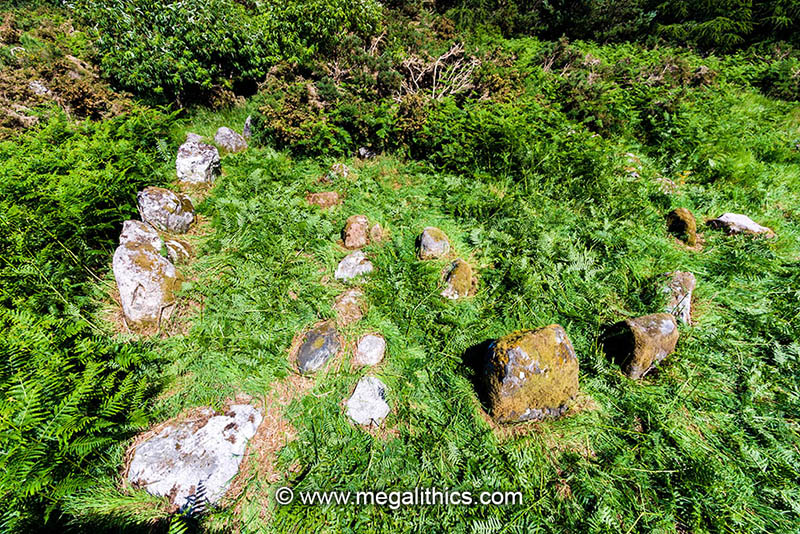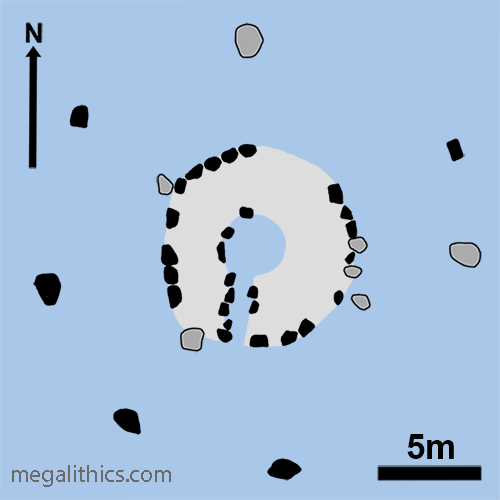 |
| NH 6215 3896 (Pub.) | Diameter - 9.4m Outer kerb (Pub.), 21.0m Stone Circle (Pub.) |
| Visited July 2010 | Alt.65m OD (Pub.) |
 |
Kinchyle of Dores ( INV 37 ), is a Clava Passage-Grave that has been extensively robbed and ruined but all of the essential structural components are identifiable. The cairn is situated about 6km SW of Inverness at the side of General Wade's Military Road, now the B862. Then monument stands on slight slope at 65m OD at the head of Loch Ness, the area is forested and their are currently no views at all from the site.

PUBLISHED ACCOUNTS
In contrast to many of the Clava monuments we have covered, there is a veritable feast of publications including Kinchyle of Dores. A telling feature here is the inclusion in many travel journals. Kinchyle stands immediately beside the B862, which is one of General Wade's Military roads, this one linking Fort William with Fort Augustus and Inverness, the road would be taken by any traveller between these points, so all would have seen Kinchyle, hence, presumably, the rich coverage.
The famed James Boswell visited Kinchyle of Dores in 1773 along with his similarly famous friend, Samuel Johnson (1). Johnson did not have a high opinion of the monument, or indeed, "Druidical Temples" as a whole "About three miles beyond Inverness, we saw, just by the road, a very complete specimen of what is called a Druid's temple. There was a double circle, one of very large, the other of smaller stones. Dr Johnson justly observed, that, 'to go and see one druidical temple is only to see that it is nothing, for there is neither art nor power in it; and seeing one is quite enough'. Or, to put this in modern parlance "you've seen one - you've seen them all". As avid fans of all things prehistorically megalithic, we rather think that Dr. Johnson was an ass.
Anderson, included Kinchyle is his 1881 survey (2) of circles and cairns on the Inverness region. He observantly spotted the larger size and height of the SW circle stone, despite the indicators of the Clava tradition being unknown at the time. He mistakenly saw the large gap in the outer kerb stones at N to NE as an entrance "The entrance to this circle is distinctly marked, and is in the NNE", and then describes the actual entrance passage as "an avenue, lined on both sides by upright stones, conducts through the second to the inner circle" in front of the western circle stone. His misinterpretation is due to the belief at the time that these monuments were comprised of three concentric stone circles only, and that the spaces encompassed had always been open and accessible. The idea that the inner two rings were revetments for a large now-vanished cairn had yet to be realised. Anderson also mentions the odd stone row between the circle stones and the outer kerbs at the NE that is shown on many early plans, but absent from modern diagrams. This area was covered by dense undergrowth during our visit and could not be checked.
Beaton includes a beautifully detailed plan of Kinchyle (which he calls "the stone circle at Scaniport") in his survey of antiquities of The Black Isle (3), but then gives no details of the monument in the text of his paper at all. It is almost as though he could not resist including such an outstanding monument, but could not cover it fully as its location precluded it from the focus of his main study.
Fraser (4) comments briefly on Kinchyle and several other ruined cairns in his survey of stone circles in the Inverness region "Of the other circles,........ very little can be said, as they are generally in a very fragmentary condition" He does publish a very good plan of Kinchyle and also some other cairns, but concludes that this shows "nearly all that can be said regarding them."
A "Druid Temple" is described by Richard Pocoke in his accounts of his Scottish tour there in 1760 (5), "we went towards Inverness and passed by a Druid temple about ten paces in Diameter, consists of flat stone about a yard above the ground set close together. Six paces from this is a circle of seven stones, some of which are fallen, they are nine paces apart, about a yard broad, and five or six feet high." A footnote gives a possible identification of the site as Kinchyle and the measurements could match, roughly. Given the proximity to the military road that Pococke would have travelled the identification is probably correct.
Piggott covered Kinchyle in his excavation survey of Clava monuments in 1952-3 (6). He excavated the central chamber area "A small bowl-shaped pit was found cut into the boulder clay, 18 ins. in diameter and 10 ins. deep, filled with dark soil, and near this to the SW. was a scatter of cremated bones with dark earth on the old surface and under a few flattish stones." He forwarded cremated bone found at the site to F.P.Lisowski at the University of Birmingham for analysis.
Lisowski (7) identified 19g of cremated human bone in the material sent to him by Piggott, comprising 7 fragments of skull and 23 of long bones. He concluded "The available amount of material is probably that of one skeleton. Neither the sex nor the age could be ascertained."
Henshall briefly covers Kinchyle in her magnum opus of 1963 (8) using Piggott's plan drawing. She expands the coverage to a detailed account with an updated diagram in her most excellent work on the Central Highland cairns (10) in 2001.
Thoms and
Burl (9)
plan the site in their work of 1980 and provide another brief
description. They do their usual analysis with measurements converted into
Thom's "Megalithic Yard", a now-discounted theory, indeed, even Burl
was later to call this "a chimera, a grotesque statistical misconception".
DESCRIPTION
We must apologise that our coverage of Kinchyle is not as complete as we would like. During our visit the site was covered by a thick layer of undergrowth, including many Gorse bush entanglements. It was so dense that we could not even see, or get to, three of the circle stones! Luckily the site must get regular visitors as there are paths to the site through the "jungle" and a lot of the bracken cover had been trampled around the cairn. Even so, it was impossible for us to get photos of the complete monument, especially the stone circle remains :O(
The outer kerb stones enclose a diameter of about 9.5mm, the ring is fairly complete except for a large gap at the NNE (Anderson,s "entrance") and the odd missing stone. The kerbs are almost intact in the western half of the circle, they are also mostly present, but displaced, on the eastern side. The outer kerb stones are very obviously more massive in the SW arc, a typical Clava trait. The exception to this is that the eastern entrance portal stone is taller and much bigger than its western counterpart. The entrance in the kerb ring is positioned just west of south, leading to a passage about 0.8m wide, the west wall of this has a nearly complete run of four stones, while the east is fragmentary with only two contiguous stones remaining. Very little of the chamber walling survives, only three stones remain at the west, two contiguous. The chamber was about 3m in diameter and the passage joins it slightly to the west. Piggott excavated the chamber floor in 1952-3 and found a scatter of cremated bone near the centre.
Of the surrounding stone circle, five stones remain erect and two are fallen, because of the undergrowth we only saw three erect and one fallen. There is said to be an intact run of four erect stones in an arc S to NW, a fallen stone at the north, an erect stone at the NE, and another fallen at the east. The tallest stone is, predictably for a Clava monument, at the SW, 1.6m tall and set with its flat face to the outside of the circle. The run of four stones have even spacing of about 6-7m and are set around 5-5.5m from the outer kerb circle. The original stone count is uncertain, Anderson's drawing shows two stones standing in the current large gap at the SE, which gave a nine stone ring in the 1820's, however the stone spacing suggests the original count may have been ten. Piggott's excavation was restricted to the chamber only, so we have no stone-hole evidence to give a conclusive count.
Although extensive robbed and ruined, enough of all of the structural elements survive to allow a picture of the intact monument to be formed, especially if you have visited the more intact Clava passage-graves at Balnuaran, and especially, Corrimony. The proximity to the road has obviously drawn many visitors over the centuries, but unless there has been extensive clearance of the undergrowth since 2010, it is currently impossible to view all the elements of Kinchyle of Dores that have survived.
1.
Boswell, J.,
The Journal of a Tour to the Hebrides with Samuel
Johnson, p.120, London, 1785.
2.
Anderson, G., Archaeologia Scotica,
3, p212-3,1831.
3.
Beaton, A.J.,
Proceedings of the Society of Antiquaries of
Scotland, 16, p.491-2,1881-2.
4.
Fraser J.,
Proceedings of the Society of Antiquaries of
Scotland, 18, p.356-7,1884.
5.
Pococke, R., "Tours in Scotland
1747,1750,1760", p.102, Scottish History Society, Edinburgh, 1887.
6.
Piggott, S.,
Proceedings of the Society of Antiquaries of
Scotland, 88, p.185-6,1952-3.
7.
Lisowski, F.P., Proceedings of the Society of Antiquaries of
Scotland, 89, p.83-90,1956.
8.
Henshall, A. S.,
The Chambered Cairns of Scotland,
p.381, Edinburgh University Press, 1963,
Edinburgh.
9.
Thom, A., Thom, A. S. and Burl, A., Megalithic
Rings, B.A.R. British Series, 81, p.272-3, 1980, Oxford.
10.
Henshall, A. S. and Ritchie J. N. G., The Chambered
Cairns of the Central Highlands, p.225-7,
Edinburgh University Press, 2001, Edinburgh.